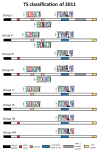Trypanosoma Cruzi Genome: Organization, Multi-Gene Families, Transcription, and Biological Implications
- PMID: 33066599
- PMCID: PMC7602482
- DOI: 10.3390/genes11101196
Trypanosoma Cruzi Genome: Organization, Multi-Gene Families, Transcription, and Biological Implications
Abstract
Chagas disease caused by the parasite Trypanosoma cruzi affects millions of people. Although its first genome dates from 2005, its complexity hindered a complete assembly and annotation. However, the new sequencing methods have improved genome annotation of some strains elucidating the broad genetic diversity and complexity of this parasite. Here, we reviewed the genomic structure and regulation, the genetic diversity, and the analysis of the principal multi-gene families of the recent genomes for several strains. The telomeric and sub-telomeric regions are sites with high recombination events, the genome displays two different compartments, the core and the disruptive, and the genome plasticity seems to play a key role in the survival and the infection process. Trypanosoma cruzi (T. cruzi) genome is composed mainly of multi-gene families as the trans-sialidases, mucins, and mucin-associated surface proteins. Trans-sialidases are the most abundant genes in the genome and show an important role in the effectiveness of the infection and the parasite survival. Mucins and MASPs are also important glycosylated proteins of the surface of the parasite that play a major biological role in both insect and mammal-dwelling stages. Altogether, these studies confirm the complexity of T. cruzi genome revealing relevant concepts to better understand Chagas disease.
Keywords: Trypanosoma cruzi strain; gene expression; genome plasticity; mucins; sequencing methods; trans-sialidases.
Conflict of interest statement
The authors declare no conflict of interest.
Figures






References
Publication types
MeSH terms
Substances
LinkOut - more resources
Full Text Sources
Medical

